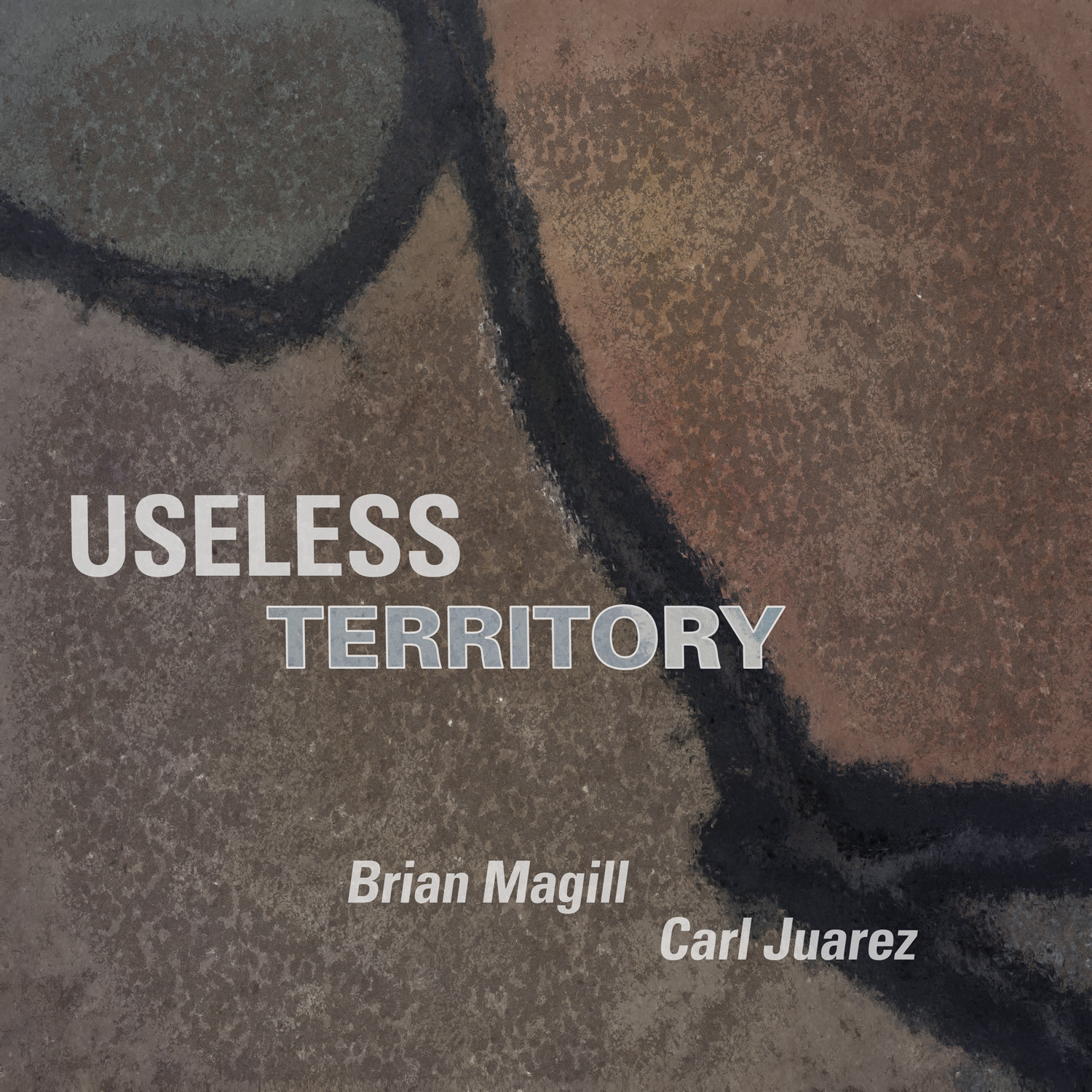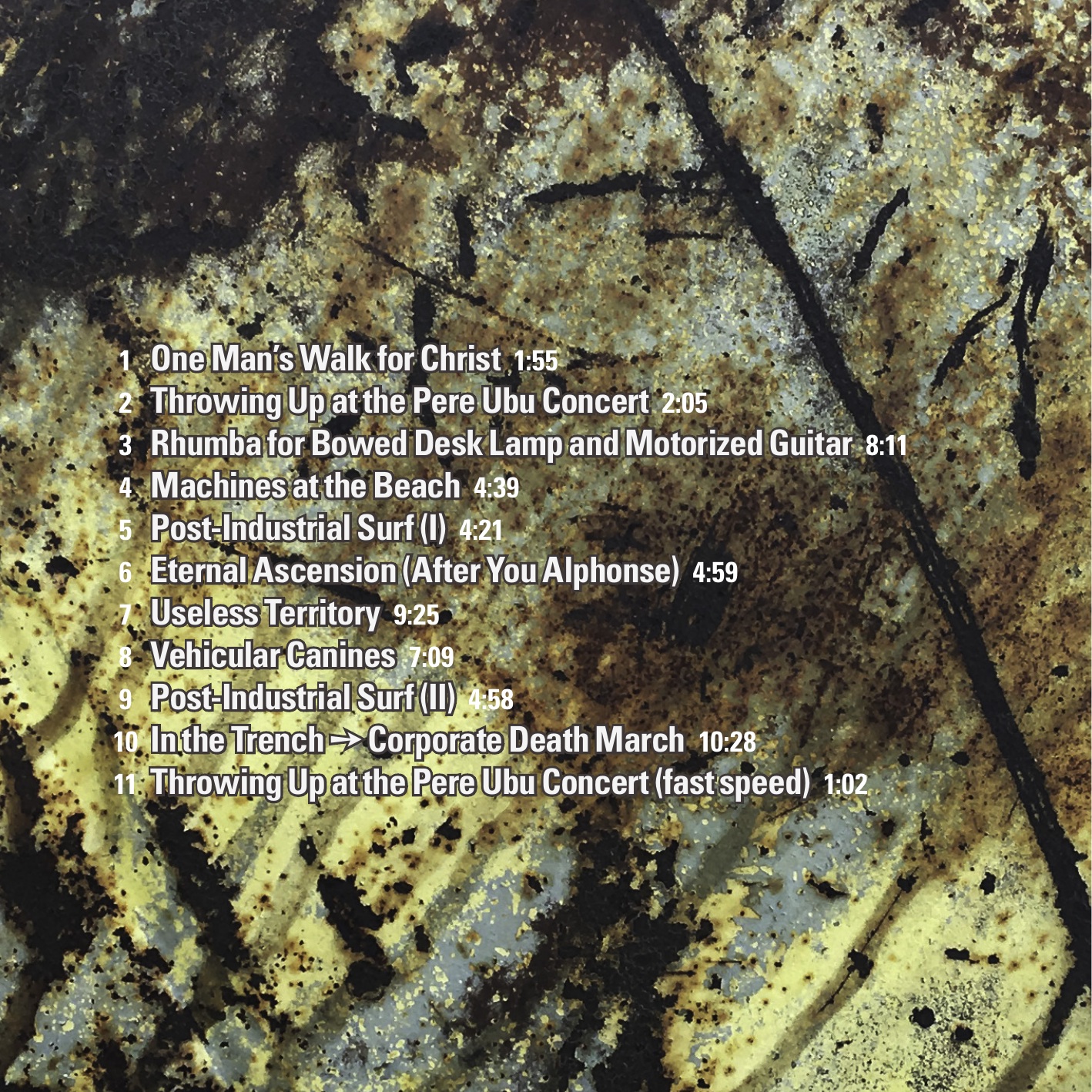Useless Territory [2019] — Liner Notes
From the liner notes of Useless Territory, published 2019.

Liminal Notes by Carl Juarez
As a pre-teen in California I’d been intrigued by electronic and experimental music since hearing Wendy Carlos’ Switched-On Bach (though she was Walter at the time) and seeing documentaries on composers like George Crumb and John Cage. Synthesizers were rare and cost thousands of dollars but could be found in piano and organ stores, as many home organs were adding a third, toy-like keyboard for a rudimentary additive synth voice, and as a nascent technophile with limited musical talent I’m sure I was something of a nuisance.
After moving to Oregon I met Brian through high school forensics in the mid-1970s. Though he lived in Beaverton (a suburb of Portland) and I was in Tillamook, a coastal logging and dairy town of 4000, with a mountain pass between us, he was already a familiar face before our paths crossed again as sophomores at the University of Oregon in Eugene in 1979.
At UO we shared an interest in the avant garde pop music associated with Brian Eno and Robert Fripp, as well as more general New Wave such as Talking Heads, Boomtown Rats, Devo, and Public Image Limited, whose iconic Metal Box I recall hearing for the first time while visiting Singles Going Steady with Brian in Portland that Christmas season. Something inviting was in the air, fusing a do-it-yourself approach to an exploratory spirit and using lack of resources less as a limiting factor than creative leverage.
The galvanizing factor when it came to actually working together was technological. Eno had pioneered (and Fripp made his own) a method of recording by sharing tape between two reel-to-reel recorders, allowing you to interactively build up waves of sustained sound, a kind of meta-instrument.
In early 1980 Brian was working at the university’s Instructional Media Center, which handled the AV needs of the campus. Somehow I prevailed upon him to check out two (only semi-portable) reel-to-reels and bring them to the nearby mini-apartment of our friend Reid Ertsgaard, where there was a foot-powered pedal organ and a Fender Rhodes electric piano, to this day the most beautiful instrument I’ve ever heard.
For several weekends that spring we experimented with this two-recorders-one-tape system, and later that year I dropped out of college to explore music and educate myself.
About this collection
In the mid-’90s I collected what I thought were the best pieces from that period for a compilation to share with Brian. Over time the source recordings have been lost and we are left with these mixes, which have been minimally processed.
Equipment
Brian Magill:
- Partially-defretted electric guitar, aka Guitar #3
- Synthesizers: Moog Satellite, ARP 2600, Korg MS-20, Octave CAT, among others
- Various miscellaneous electric keyboards
- Fretless electric bass
- TASCAM Portastudio 244 4-track cassette recorder
Carl Juarez:
- Cheap electric guitar
- Electro-Harmonix Guitar Microsynth
- Various other secondhand and kit-built stomp boxes
- Roland TR-606 portable drum machine
- Portable radio/speaker, aka Little White Thing
On “famous” adapters — We used a lot of RCA female to 1/4” male adapters when working, often to cobble together some bizarre bit of electrical plumbing to connect one device to another. We had so many around I put star stickers on mine to keep track.
At one point I wanted to suggest we give them a short nickname for ease of reference, and as I was saying so I realized that were we to become famous then people might want to know what we called them, with the result that I blurted out famous adapters! and that was what we called them forever after.

Track notes
1 — One Man’s Walk for Christ 1:55
A chance jape, recorded in Eugene.
CJ: Field recording
2 — Throwing Up at the Pere Ubu Concert 2:05
Our first recorded composition from the summer of 1980, recorded in a sublet apartment with two reel-to-reel tape decks and sundry borrowed and found instruments: acoustic guitar, a guitar slide rolled across the top of a guitar case with the mic inside, a shaken jar of marbles, two jar lids played with sticks, and a desk lamp with the mic pinioned between its struts, a kind of combination audio and contact mic.
(Another piece from that summer using even fewer materials is Music for Alien Encounter @ archive.org/details/nTopia)
3 — Rhumba for Bowed Desk Lamp and Motorized Guitar 8:11
Recorded, as were most of these pieces, in the basement where we had apartments with a shared bathroom.
By this time we had graduated to cassette decks, mixed with the classic four-channel Radio Shack pan-less mixer of the era. This encouraged live improvisation as overdubbing was both painful and low-fi.
When our schedules permitted we would cobble together some combination of instruments, equipment, and effects into a configuration for recording, start the tape, and try to create interesting sounds with the hopes of making music. There was no evident commercial potential for this post-industrial bricolage but in DIY punk spirit we made it anyway.
CJ: Electric guitar and electric motor, field recording
BM: Bowed (and struck) desk lamp, drum programming
4 — Machines at the Beach 4:39
Another basement jam, using a field recording of a supermarket checkout line (probably slowed via reel-to-reel) for background. The lead synth is being triggered by signals from the TR-606 drum machine, which develop over the course of the piece.
CJ: Synth, live drum programming
BM: Synth, time-stretched field recording
5 — Post-Industrial Surf (I) 4:21
Another live jam, the departure point for which was a small group of mounted RCA jacks wired into a cross-channel echo matrix by O.M. Kvern. One curious side-effect of this arrangement is that the recording does not include the actual sounds, just their echoes, leaving out one layer of syncopation.
In a sense this exploratory improvisation (and its companion) is an exemplar of human spirit melding with enabling technology to joyously create and discover new beauty.
CJ: Electric guitar (single notes), effects
BM: Guitar #3 (chords), effects, live mix
6 — Eternal Ascension (After You Alphonse) 4:59
A synth duet recorded during a working visit of the Kvern brothers from Seattle that also produced Queen of Ghost Dance in 1984 (available on Industrial Frictions, see n-topia.bandcamp.com). The aggregated equipment — including two 4-track Portastudios — enabled simultaneous recording in both apartments and quick bouncing of tracks. One technique we used for better fidelity was pulling out a buss bar on the back of the PS to bypass its (relatively noisy) preamps.
In this case two synths — ARP 2600 & Pro-One? — are synced together and CJ is varying the pitch relationship between them while he and Brian improvise on keyboard.
7 — Useless Territory 9:25
Alas, my memory fails on this piece, which was masterminded by Brian (who doesn’t recall either). I can recognize my vocalizations but little else.
8 — Vehicular Canines 7:09
Recorded in Seattle, when Brian visited after I moved there in September of 1984.
CJ: Electric guitar with frictions and effects, Sequential Circuits Pro-One synth, Roland TR- 606 drum machine, live mix
BM: Bowed hi-hat
Pro-One sequence programmed by O.M.Kvern
9 — Post-Industrial Surf (II) 4:58
Using the same setup as Post-Industrial Surf (I) above, with the addition of fretless bass, radio and application of an electric motor to the guitar.
CJ: Electric guitar, electric motor, effects
BM: Electric fretless bass, effects, radio, live mix
10 — In the Trench ➙ Corporate Death March 10:28
A straight-to-cassette jam recorded at Derryl Parsons’ home studio in Eugene, 1984, while he was out. (We miss you, Derryl.) Though the original recording was to two channels it was not actually a stereo mix (most sounds were entirely in one channel or the other); I have remastered into something more stereolike for comfort of listening.
CJ: Electric guitar, effects, Yamaha digital delay
BM: Derryl’s synths, including Korg MS-20 & Mono/Poly
11 — Throwing Up at the Pere Ubu Concert (fast speed) 1:02
Having used multiple speeds in the course of recording, the result was fluid in terms of final speed. This is the double-speed version.